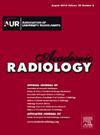Intratumoral and Peritumoral Radiomics for Predicting the Prognosis of High-grade Serous Ovarian Cancer Patients Receiving Platinum-Based Chemotherapy.
IF 3.8
2区 医学
Q1 RADIOLOGY, NUCLEAR MEDICINE & MEDICAL IMAGING
引用次数: 0
Abstract
RATIONALE AND OBJECTIVES This study aimed to develop a deep learning (DL) prognostic model to evaluate the significance of intra- and peritumoral radiomics in predicting outcomes for high-grade serous ovarian cancer (HGSOC) patients receiving platinum-based chemotherapy. MATERIALS AND METHODS A DL model was trained and validated on retrospectively collected unenhanced computed tomography (CT) scans from 474 patients at two institutions, which were divided into a training set (N = 362), an internal test set (N = 86), and an external test set (N = 26). The model incorporated tumor segmentation and peritumoral region analysis, using various input configurations: original tumor regions of interest (ROIs), ROI subregions, and ROIs expanded by 1 and 3 pixels. Model performance was assessed via hazard ratios (HRs) and receiver operating characteristic (ROC) curves. Patients were stratified into high- and low-risk groups on the basis of the training set's optimal cutoff value. RESULTS Among the input configurations, the model using an ROI with a 1-pixel peritumoral expansion achieved the highest predictive accuracy. The DL model exhibited robust performance for predicting progression-free survival, with HRs of 3.41 (95% CI: 2.85, 4.08; P < 0.001) in training set, 1.14 (95% CI: 1.03, 1.26; P = 0.012) in internal test set, and 1.32 (95% CI: 1.07, 1.63; P = 0.011) in external test set. KM survival analysis revealed significant differences between the high-risk and low-risk groups (P < 0.05). CONCLUSION The DL model effectively predicts survival outcomes in HGSOC patients receiving platinum-based chemotherapy, offering valuable insights for prognostic assessment and personalized treatment planning.瘤内和瘤周放射组学用于预测接受铂类化疗的高级别浆液性卵巢癌患者的预后
原理与目的本研究旨在开发一种深度学习(DL)预后模型,以评估瘤内和瘤周放射组学在预测接受铂类化疗的高级别浆液性卵巢癌(HGSOC)患者预后中的重要性。材料和方法对两家机构回顾性收集的474名患者的未增强计算机断层扫描(CT)扫描结果进行了DL模型的训练和验证,这些扫描结果被分为训练集(N = 362)、内部测试集(N = 86)和外部测试集(N = 26)。该模型包含肿瘤分割和瘤周区域分析,使用不同的输入配置:原始肿瘤感兴趣区(ROI)、ROI 子区域以及扩大 1 和 3 像素的 ROI。模型性能通过危险比(HR)和接收器操作特征曲线(ROC)进行评估。结果在输入配置中,使用瘤周扩展 1 像素 ROI 的模型预测准确率最高。DL 模型在预测无进展生存期方面表现稳健,训练集的 HR 值为 3.41 (95% CI: 2.85, 4.08; P < 0.001),内部测试集的 HR 值为 1.14 (95% CI: 1.03, 1.26; P = 0.012),外部测试集的 HR 值为 1.32 (95% CI: 1.07, 1.63; P = 0.011)。结论 DL模型能有效预测接受铂类化疗的HGSOC患者的生存结果,为预后评估和个性化治疗方案提供有价值的见解。
本文章由计算机程序翻译,如有差异,请以英文原文为准。
求助全文
约1分钟内获得全文
求助全文
来源期刊

Academic Radiology
医学-核医学
CiteScore
7.60
自引率
10.40%
发文量
432
审稿时长
18 days
期刊介绍:
Academic Radiology publishes original reports of clinical and laboratory investigations in diagnostic imaging, the diagnostic use of radioactive isotopes, computed tomography, positron emission tomography, magnetic resonance imaging, ultrasound, digital subtraction angiography, image-guided interventions and related techniques. It also includes brief technical reports describing original observations, techniques, and instrumental developments; state-of-the-art reports on clinical issues, new technology and other topics of current medical importance; meta-analyses; scientific studies and opinions on radiologic education; and letters to the Editor.
 求助内容:
求助内容: 应助结果提醒方式:
应助结果提醒方式:


